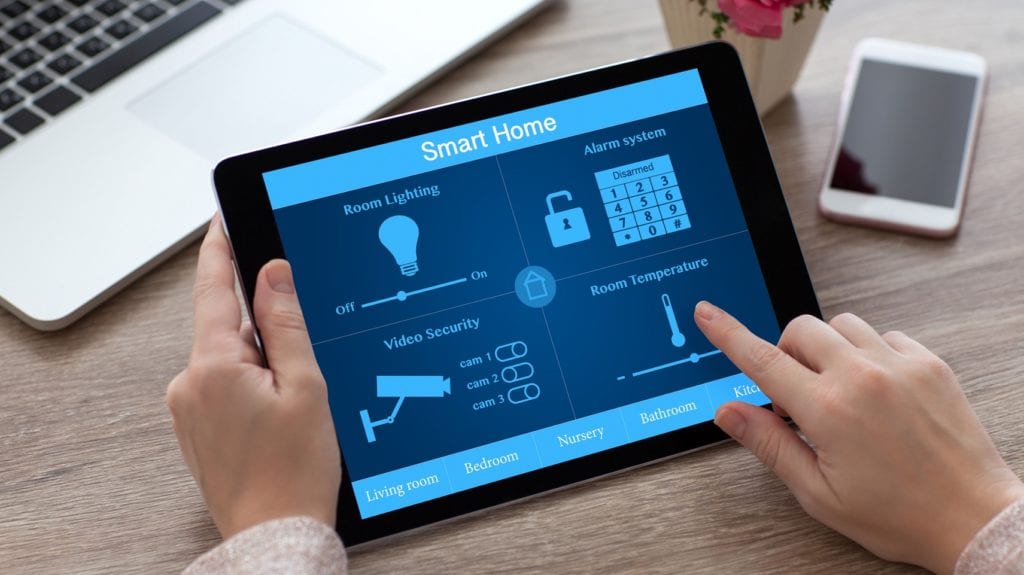The guide to getting your house connected

Photo: Getty/Images/Prkhodov
Smart phones, smart TVs and now smart homes? Sure, you’ve heard all about it, but what does it all mean?
Don’t worry, you’re not dropping in IQ points and robots aren’t taking over the world, technology is just evolving to make life easier for you and the smart home concept might just be the best “smart” yet.
“In the simplest terms, a smart home is the idea that all of the different devices in the home work in concert with each other in an easy-to-use way to make everyday life simple and easier for you,” says Paul Williams, vice president of product at Control4, a leading smart home technology provider based in Salt Lake City, Utah.
A simpler life sounds pretty appealing, right? With tips from the professionals, we can help you learn how to build a smart home and get you on your way to an easily managed home in no time.
Getting Started
As there are loads of different options — smart door locks, smart window shades, smart lighting, smart sound systems, etc. — it’s best to start by asking yourself what you want to accomplish when building a smart home. Maybe you started off with buying Nest, Google’s much celebrated smart thermostat, and want to learn how to make your new home more automated. Whether you’re a self-proclaimed technophile or the thought of new technology makes your head spin, a smart home can make life easier to manage for any busy family.
“There are many benefits to having a smart home,” says Williams. “Among them are safety and security, energy conservation and simplifying the consumer’s life.”
Let’s dive into each and see what piques your interest:
Safety and Security
According to Icontrol Networks, a smart home technology provider based in Redwood City, Calif., security remains the No. 1 reason driving people to adopt the smart home concept — so much so that 90 percent of consumers in the market say family security is one of the top reasons to purchase a smart home system.
“You get peace of mind when you’re away knowing your house is secure, knowing when your kids are coming and going, who’s at the front door,” says Rich Bira, managing director for Fibaro USA, a smart home technology provider.
“Some of the smart devices that help achieve this are smoke, motion and water sensors,” he says, which can detect fires, flooding and broken water lines, and when there is unwelcome movement in or around your home. Some smart door locks, for example, can alert you via smartphone or tablet when your door is opened — whether by a young child returning from school or by someone who’s not meant to access your home — while you are away.
The following are some gadgets to look for when planning for safety and security:
- Motion sensors: for detecting unwelcome movement in your home and around doors and windows
- IP cameras: for monitoring what’s going on in or around the home
- Leak detectors: for detecting leaks from appliances and piping
- Smoke and gas detectors: for detecting fires and gases like carbon monoxide
- Smart door locks: for ease of operation and monitoring while away from home
Energy Conservation
Having a thermostat that shuts off the AC when you walk out the door. Lighting that turns off when everyone leaves the room. Shades that shut automatically when the sun is raising the room temperature.
Not only do these things save you time; they save you money. Smart home devices can be programmed to conserve energy, which is both good for your wallet and the environment.
According to Icontrol, 70 percent of consumers cite energy efficiency as a driving factor in smart home interest. And with all the options out there, you should be excited too:
- Motion sensors: for switching off lights when there is no movement or when you say so
- Smart thermostat: for adjusting the temperature according to your schedule and preferences
- Smart sprinkler control: for watering the lawn only when needed
- Smart blinds or shades: for operation according to room temperature
The Simple Life
We admit it: sometimes it’s OK to be lazy and smart homes can help with that. It can be designed for you and by you, so you can make that home as smart and easily manageable as you want it to.
These gadgets don’t even begin to scratch the surface, but imagine: lights that you never have to get up to turn off, locks that open on their own as you approach the front door, sound systems you can control by voice command, TVs that have computer access, clothes washers and ovens that you can control all while out of the home — the possibilities are limitless.
We’re not even going to begin to create a list — as it would go on for miles — but if you can think of a way to make your home life easier, chances are there’s a smart home gadget out there for you already. Just ask your local smart home provider or technology expert about what you’re looking for and they’d be happy to point you in the right direction.
Feeling Tech Challenged?
Admittedly, there are a lot of “smart” gadgets. Worried there might be too many or that you might not be tech-savvy enough to handle it? Smart home pros say anyone can have a smart home — and they’re always happy to help those who need assistance.
“Most smart products come with a mobile app to control each individual device, but what’s even better is when you can control them all together,” says Williams.
The best part of all these gadgets? Generally, they can all be connected to a centralized operating system, which you can access from your smartphone or tablet. So all these great benefits? Yeah, you can access each and every one with the tap of a finger and get mobile alerts when something needs your attention.
Feel like you left the doors unlocked on the rush to work? Check your Android. Did you leave the AC too low? Pull out your iPad. Want to turn down the lights without having to leave the couch? Don’t be ashamed, whip out that iPhone.
Still feeling a little overwhelmed by all this gadget talk? There are solutions for you still.
“People don’t have to necessarily start with a full smart home concept in mind, they can just start with an individual device,” says Williams. “It’s when you start to connect a few devices that you start to have a smart home.”
But be warned, once you start with one, the odds are you’ll be back for more.
“It’s usually that first one that serves as an entry point,” says Bira. “After they have gotten a taste of a smart home product, that’s when they realize they can’t live without that smart product and they want to continue to add more to it.”
If you’re ready to make the smart home leap, research smart home brands to figure out which ones can help you manage each system from a central unit. Some will even have the experts come to you to help you master plan your system and most systems even allow different brands to connect, so you don’t usually have to stick with one manufacturer.
Once it’s all said and done, whether you opt for one or 101 gadgets, you’ll be on your way to having the smartest home on the block.

Drew Knight is a former writer and editor for HomLuv.com’s parent company, Builders Digital Experience (BDX).

 Pool Safety Tips
Pool Safety Tips